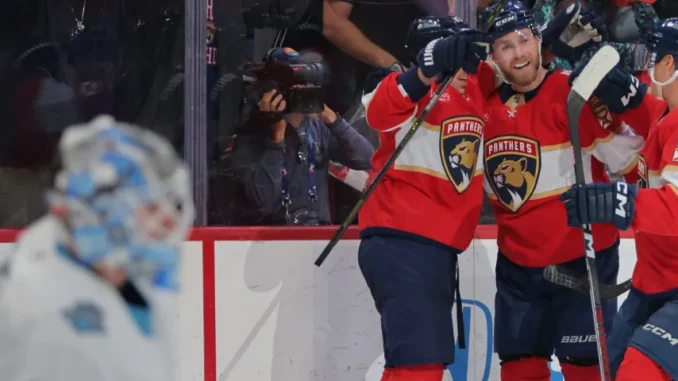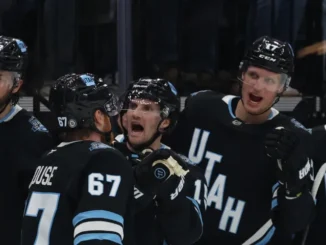
The Utah Hockey Club (UHC) had a promising season, but ultimately, they fell short of expectations. As with many sports teams, identifying what went wrong is a crucial exercise, and for the UHC, a deeper look into the gaps in their roster, strategy, and execution can provide insight into why they couldn’t achieve the success fans and analysts hoped for. The following explores several key factors that contributed to the UHC’s struggle and what was missing this season.
1. Lack of Offensive Depth
One of the most glaring issues the Utah Hockey Club faced this season was a lack of offensive depth. While the team had a few standout players capable of putting up impressive point totals, the overall offensive production was inconsistent. In hockey, success is not only determined by a few star players but also by how well the entire team contributes to the offensive game.
In particular, the UHC struggled with scoring on special teams, with a power play percentage that ranked lower than league average. This lack of production in critical situations hurt their chances of staying competitive in tight games. Furthermore, when top-line players were contained or dealt with injury, there wasn’t enough secondary scoring to pick up the slack. Depth scoring is essential in a league where opponents can focus on shutting down star players. The UHC’s inability to consistently produce across all four lines contributed to a number of frustrating losses throughout the season.
2. Inconsistent Goaltending
Goaltending is often the difference between success and failure in hockey, and for the Utah Hockey Club, it became a point of concern. While their primary goaltender displayed flashes of brilliance, inconsistency was a recurring theme in his performance. In a sport where one bad goal can alter the momentum of an entire game, the UHC struggled to find stability between the pipes.
A solid goaltender can steal games and keep teams in contests they might otherwise lose. However, the UHC’s goaltending duo couldn’t quite deliver the level of play needed to provide that edge. At times, their netminders allowed soft goals or weren’t able to make key saves when the team needed it the most. This lack of consistency ultimately made the defense’s job much harder, and the team couldn’t rely on the back end to bail them out in critical moments.
3. Defensive Zone Breakdown
The UHC defense was another area where they faltered this season. While the team had a few standout defensemen, as a whole, the defensive unit struggled with coverage in their own zone. Too many times, opponents were able to take advantage of breakdowns in the defensive zone, leading to high-quality scoring chances. This was particularly evident when the team played against high-caliber offenses, where they were overwhelmed by speed and precision.
The defensive lapses not only resulted in goals but also contributed to the team’s inability to sustain possession or generate offensive opportunities. When defensemen failed to clear the puck effectively or allowed forwards to create sustained pressure, the team often found themselves trapped in their own zone, resulting in exhaustion and missed opportunities on the attack. In some of the tougher games of the season, it was clear that the UHC defense lacked the cohesion and consistency required to shut down opposing offenses effectively.
4. Team Chemistry and Communication Issues
As with any team sport, chemistry and communication are vital to a team’s success, and the UHC experienced issues in both areas. In hockey, the fluidity of play requires constant communication between forwards, defensemen, and goaltenders. Unfortunately, this aspect of the UHC’s game appeared to break down frequently.
Miscommunications on the ice often led to turnovers, blown coverages, and lost battles for pucks in key areas. Additionally, players seemed to struggle with finding consistent line combinations that clicked. When lines were shuffled, it took time for players to adjust to their new roles, and this inconsistency in lineups only compounded the problem. A team that lacks cohesion cannot execute plays effectively, and this showed in the UHC’s erratic performances.
5. Injuries to Key Players
Injuries are an inevitable part of any season, and the UHC was not immune to this unfortunate reality. Key players, including several top forwards and defensemen, missed extended periods of time due to injury. While the team had some capable players who could step in during these absences, the loss of their star contributors impacted their overall success.
In hockey, the gap between healthy and injured players can often be quite large, especially when it comes to top-tier talent. When the UHC lost their core players to injury, it left a hole in both their offensive and defensive systems. The players who filled in were not necessarily of equal caliber, and this difference was often felt in critical moments during the season. Injuries may not have been the sole reason for the UHC’s downfall, but they were certainly a contributing factor that impeded their ability to compete at the highest level.
6. Coaching and Strategy Adjustments
Another important factor that may have contributed to the Utah Hockey Club’s struggles was the team’s coaching and overall strategy. While their head coach is undoubtedly knowledgeable and has had success in the past, there were moments when the team seemed stagnant and unable to adjust to changing circumstances.
In certain games, the UHC appeared to be stuck in a system that didn’t suit the players’ strengths, especially when facing high-paced, aggressive teams. Whether it was tactical adjustments or individual player development, the lack of strategic flexibility may have prevented the team from capitalizing on key moments in the season. The UHC’s coaching staff needed to find ways to make in-game adjustments that could stem the tide of a losing streak or rally the team in close contests, but these moments of tactical brilliance were few and far between.
Conclusion: What’s Next for the Utah Hockey Club?
The Utah Hockey Club’s season was a combination of highs and lows, but it ultimately highlighted several areas in need of improvement. From a lack of offensive depth to inconsistent goaltending, defensive zone breakdowns, communication issues, and injuries, the UHC’s challenges were numerous.
Looking forward, the team must focus on bolstering its offensive depth, solidifying its defensive coverage, and ensuring that the goaltending position is both stable and reliable. Team chemistry must be built from the ground up, and injuries need to be minimized with better fitness regimens. On the coaching side, strategic flexibility and in-game adjustments will be paramount to future success.
Though this season didn’t live up to expectations, the Utah Hockey Club has the potential to grow and rebuild for a more successful future. With the right moves in the offseason and a renewed focus on teamwork, they can position themselves to compete at the highest level next season.

Be the first to comment